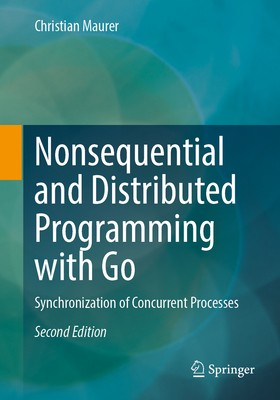
- We will send in 10–14 business days.
- Author: Christian Maurer
- Publisher: Springer
- ISBN-10: 3662709287
- ISBN-13: 9783662709283
- Format: 17.3 x 23.9 x 3.1 cm, softcover
- Language: English
- SAVE -10% with code: EXTRA
Nonsequential and Distributed Programming with Go (e-book) (used book) | bookbook.eu
Reviews
Description
After a short chapter on basic aspects of software engineering and its realization in Go, this book introduces to nonsequential and distributed programming with Go. It systematically presents basic concepts for the synchronization and communication of concurrent processes. These include locks, semaphores, fairness and deadlocks, monitors, local and network-wide message passing, networks as graphs, network exploration, distributed depth and breadth first search, and the selection of a leader in networks. In order to make readers familiar with the concepts, the author always takes up the same classic examples. This makes learning easier, because the concepts presented can be compared more easily with the language resources.
The algorithms are formulated in the Go programming language, which can be used to express numerous synchronization concepts. Due to its simple syntax, Go also offers the advantage that readers without prior knowledge can follow the basic concepts. The chapters on locks, semaphores, monitors and network-wide message passing also present some basic approaches to programming in C and Java. All source texts are available online. Besides a number of error corrections and smaller updates, in this second edition the nanouniverse nU is replaced with the microuniverse μU. This allows for beautiful animations in many places, which are not possible with the nanouniverse due to a lack of the necessary support for inputs and outputs; e.g. in the chapters on fairness, messages, farMonitors, traversals and election.EXTRA 10 % discount with code: EXTRA
The promotion ends in 19d.00:03:33
The discount code is valid when purchasing from 10 €. Discounts do not stack.
- Author: Christian Maurer
- Publisher: Springer
- ISBN-10: 3662709287
- ISBN-13: 9783662709283
- Format: 17.3 x 23.9 x 3.1 cm, softcover
- Language: English English
After a short chapter on basic aspects of software engineering and its realization in Go, this book introduces to nonsequential and distributed programming with Go. It systematically presents basic concepts for the synchronization and communication of concurrent processes. These include locks, semaphores, fairness and deadlocks, monitors, local and network-wide message passing, networks as graphs, network exploration, distributed depth and breadth first search, and the selection of a leader in networks. In order to make readers familiar with the concepts, the author always takes up the same classic examples. This makes learning easier, because the concepts presented can be compared more easily with the language resources.
The algorithms are formulated in the Go programming language, which can be used to express numerous synchronization concepts. Due to its simple syntax, Go also offers the advantage that readers without prior knowledge can follow the basic concepts. The chapters on locks, semaphores, monitors and network-wide message passing also present some basic approaches to programming in C and Java. All source texts are available online. Besides a number of error corrections and smaller updates, in this second edition the nanouniverse nU is replaced with the microuniverse μU. This allows for beautiful animations in many places, which are not possible with the nanouniverse due to a lack of the necessary support for inputs and outputs; e.g. in the chapters on fairness, messages, farMonitors, traversals and election.

Reviews